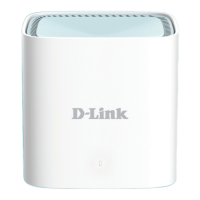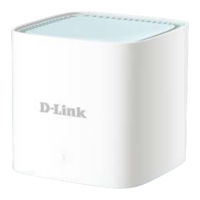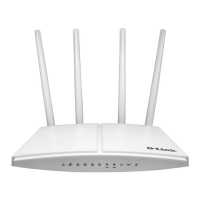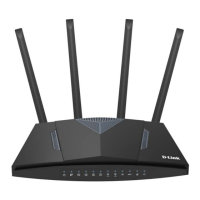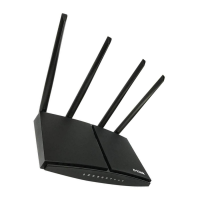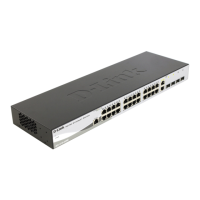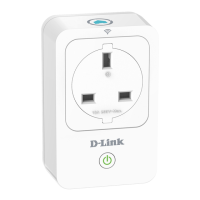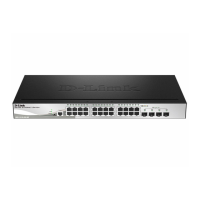Do you have a question about the D-Link M15 and is the answer not in the manual?
| Security | WPA3 |
|---|---|
| MU-MIMO | Yes |
| Beamforming | Yes |
| Product Type | Mesh Wi-Fi System |
| Model | M15 |
| Parental Controls | Yes |
| Guest Network | Yes |
| Mobile App | D-Link Wi-Fi App |
| Voice Control | Amazon Alexa, Google Assistant |
| Frequency Bands | Dual-band |
| Wi-Fi Speed | AX1500 |
| Security Protocols | WPA3, WPA2, WPA |
| Maximum Data Rate | 1500 Mbps |
| Ethernet Ports (Per Unit) | 1 x Gigabit WAN port, 2 x Gigabit LAN ports |
Lists changes made to the manual across different versions.
Lists trademarks owned by D-Link and other companies.
Details the energy consumption and standby mode of the device.
Lists all items included in the product package.
Specifies network prerequisites like modem and wireless client standards.
Details computer and browser requirements for accessing the setup interface.
Lists requirements for using the companion mobile application.
Highlights the main functionalities and advantages of the M15 router.
Explains seamless device connection to the strongest signal and optimal channel.
Describes the easy auto-pairing setup process for the mesh capability.
Details assigning devices to profiles for access control and reporting.
Explains how to scale the network with additional M15 units.
Describes connecting to an existing router for expanded coverage.
Covers mobile app and web browser setup options, including WPS.
Explains the meaning of different LED status lights on the M15 router.
Restores factory default settings by holding the recessed button.
Port for connecting the broadband modem to the router.
Port for connecting wired network devices like computers.
Step-by-step guide to set up and configure the router using the mobile application.
Connect the M15 router to your broadband modem using an Ethernet cable.
Power on the M15 and connect a computer wirelessly to its network.
Access the router's setup URL via a web browser and follow instructions.
Explains how to access and log in to the router's web management interface.
Accesses AI-driven reports on network traffic and optimization.
View details of the IPv4 and IPv6 Internet connection configurations.
Disconnect from the Internet and request a new IP address assignment.
Navigate to access the M15's network or wireless configuration pages.
Enable and configure parental controls for individual connected devices.
Create or select profiles for applying parental control settings to clients.
Displays the MAC address of the connected mesh extender.
Flash the extender's status LED to help identify it.
Opens the setup wizard for initial device configuration.
Configure the IPv4 Internet connection type and settings.
Select the desired Internet connection type from a drop-down menu.
Access advanced configuration options for DHCP connections.
Access advanced configuration options for Static IP connections.
Access advanced configuration options for PPPoE connections.
Access advanced configuration options for PPTP connections.
Access advanced configuration options for L2TP connections.
Access advanced configuration options for DS-Lite connections.
Select the desired IPv6 connection type from a drop-down menu.
Configure DNS server addresses for the IPv6 connection.
Configure local IPv6 address settings for the M15.
Enables or disables automatic IPv6 address assignment.
Selects the IPv6 autoconfiguration method (SLAAC/DHCPv6).
Enables or disables the use of link-local IPv6 addresses.
Enter the static IPv6 address provided by the ISP.
Configure DNS server addresses for the auto-configured IPv6 connection.
Configure local IPv6 address settings for the M15.
Specify the primary DNS server for the 6rd connection.
Specify the secondary DNS server for the 6rd connection.
Configure advanced settings for IPv6 Unique Local Addresses.
Enable or disable the Triple-Play VLAN feature for network segmentation.
Enable or disable the Wi-Fi Mesh feature for expanded network coverage.
Enable a single Wi-Fi network name across different frequency bands.
Configure basic Wi-Fi settings like SSID and password.
Enable or disable WPS Push Button Configuration for easy device connection.
Configure the settings for the separate guest Wi-Fi network.
Configure local network settings like IP address and subnet mask.
Access advanced network settings like WAN port speed and UPnP.
Configure the device's operational mode: router, extender, or bridge.
Configure Internet access and website blocking for devices.
Enables intelligent traffic flow management and bandwidth allocation.
Enables Demilitarized Zone to expose a client to the WAN.
Enables Stateful Packet Inspection for enhanced network security.
Define the source IP address range for firewall rules.
Define the destination IP address range for firewall rules.
Specify the local IP address for port forwarding rules.
Define the TCP ports to be forwarded.
Specify the local IP address for the virtual server.
Select the protocol (TCP, UDP, Both) for the virtual server.
Define the destination IP address of the subnetwork for static routes.
Enable or disable the Dynamic DNS feature for remote access.
Enable or disable the Quick VPN server using L2TP/IPSec protocol.
Configure device time, time zone, and schedules for various functions.
Configure the device's time zone and synchronize time with NTP servers.
Configure sending system logs to a Syslog server.
Configure email notifications for system log events.
Set or change the administrator password for device access.
Enable secure HTTPS connection for device management.
Back up current configuration settings to a local hard drive.
Reset all device settings to their factory defaults.
Set the username for a new user account.
Check the router for available firmware updates.
Configure and schedule automatic firmware updates.
View traffic statistics for the router's Internet, LAN, and Wi-Fi interfaces.
Add mesh devices to your network using the mobile application.
Optimizes Wi-Fi environment by selecting the cleanest channel.
Manages traffic flow and prioritizes devices using the QoS engine.
Manages parental controls and website filtering via the app.
Provides access to local web management interfaces.
View device details and configure Internet connection and password.
View client details, traffic statistics, and assign priority levels.
Guides through setting up Google Home integration for voice control.
Use the WPS button for easy wireless device connection.
Step-by-step guide to configure Quick VPN on Windows 10.
Step-by-step guide to configure Quick VPN on Android devices.
Step-by-step guide to configure Quick VPN on macOS.
Step-by-step guide to configure Quick VPN on iOS devices.
Troubleshoots issues accessing the router's web interface.
General hardware and Wi-Fi specifications including interfaces and data rates.
Lists supported WAN interface types such as Static IP, PPPoE, and L2TP.
FCC statement regarding device interference and compliance with regulations.
D-Link's commitment to environmental responsibility in product design and packaging.

